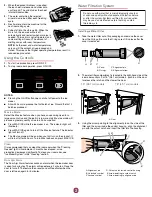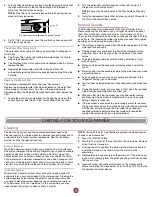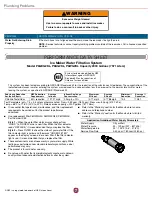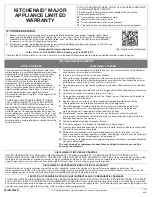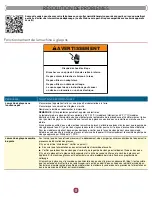
3
4
. Turn the filter clockwise until it locks into the housing. Ensure that
the alignment arrow on the filter head aligns with the locked
symbol on the control box housing.
NOTE: If the filter is not correctly locked into the housing, the ice
maker will not produce ice.
5
. For 15" (38.1 cm) models, push the control box door closed until
the latch snaps closed.
The Water Filter Status Light
The water filter status lights will help you know when to change your
water filter.
■
The “Order Filter” status light will be illuminated when it is time to
order a replacement filter.
■
The “Replace Filter” status light will be illuminated when it is time to
replace the filter.
■
Replacing the disposable water filter with a new filter will
automatically reset the filter status tracking feature. See “Using the
Controls.”
Replace the Water Filter
To purchase a replacement water filter, see “Accessories.”
Replace the disposable water filter when indicated on the water filter
status display or at least every 9 months. If the ice making rate
decreases before the Replace Filter light illuminates, then replace the
filter.
1. Locate the water filter compartment in the right-hand side of the
control housing. See Step 3 in the “Install Water Filter” section.
2. Turn the water filter counterclockwise (to the left), and pull it
straight out of the compartment.
NOTE: There may be some water in the filter. Some spilling may
occur.
3. Install the replacement water filter by following steps 2 through 5 in
the “Install the Water Filter” section.
Normal Sounds
Your new ice maker may make sounds that are not familiar to you.
Because the sounds are new to you, you might be concerned about
them. Most of the new sounds are normal. Hard surfaces such as
floors, walls and cabinets can make the sounds seem louder than they
actually are. The following describes the kinds of sounds that might be
new to you and what may be making them.
■
You will hear a buzzing sound when the water valve opens to fill the
water pan for each cycle.
■
Rattling noises may come from the flow of the refrigerant or the
water line. Items stored on top of the ice maker can also make
noises.
■
The high-efficiency compressor may make a pulsating or high
pitched sound.
■
Water running over the evaporator plate may make a splashing
sound.
■
Water running from the evaporator plate to the water pan may make
a splashing sound.
■
As each cycle ends, you may hear a gurgling sound due to the
refrigerant flowing in your ice maker.
■
You may hear air being forced over the condenser by the condenser
fan.
■
During the harvest cycle, you may hear a “thud” when the ice sheet
slides from the evaporator onto the cutter grid.
■
When you first start the ice maker, you may hear water running
continuously. The ice maker is programmed to run a rinse cycle
before it begins to make ice.
■
If the ice maker is connected to a water supply pressure in excess
of 60 psi, you may hear a loud sound during water filling associated
with the flow of water through the inlet valve. Call a licensed,
qualified plumber to determine the best method to reduce the
supply water pressure (50 psi is recommended).
Cleaning
The ice making system and the air cooled condenser need to be
cleaned regularly for the ice maker to operate at peak efficiency and to
avoid premature failure of system components. See the “Ice Maker
System” and the “Condenser” sections.
Exterior Surfaces
Wash the exterior enamel surfaces and gaskets with warm water and
mild soap or detergent. Wipe and dry. Regular use of a good household
appliance cleaner and wax will help maintain the finish. Do not use
abrasive cleaners on enamel surfaces as they may scratch the finish.
For products with a stainless steel exterior, use a clean sponge or soft
cloth and a mild detergent in warm water. Do not use abrasive or harsh
cleaners. Do not use chlorine bleach on the stainless steel surfaces.
Ice Maker System
Minerals that are removed from water during the freezing cycle will
eventually form a hard scaly deposit in the water system. Cleaning the
system regularly helps remove the mineral scale buildup. How often
you need to clean the system depends upon how hard your water is.
With hard water of 15 to 20 grains/gal. (4 to 5 grains/liter), you may
need to clean the system as often as every 9 months.
NOTE: Use one 16 oz (473 mL) bottle of approved ice maker cleaner.
To order, see “Accessories.”
1. Press the ON/OFF button.
2. Wait 5 to 10 minutes for the ice to fall into the storage bin. Remove
all ice from the storage bin.
3. Unscrew the drain cap from the bottom of the water pan located
inside the storage bin as shown. Allow the water to drain
completely.
4. Replace the drain cap securely on the water pan. If the drain cap is
loose, water will empty from the water pan and you will have either
thin ice or no ice.
5. Read and follow all handling information on the cleaner bottle
before completing the steps below. Use one 16 oz (473 mL) bottle
of approved ice maker cleaner.
A. Alignment arrow aligned with locked symbol
A
CARING FOR YOUR ICE MAKER


